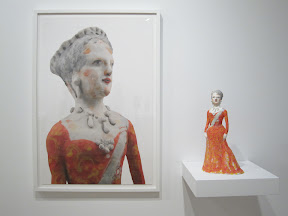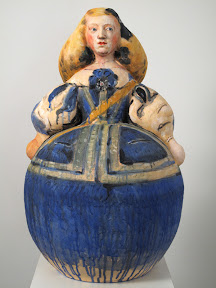This is the third time I have seen him and his work. I have admired his creative ability since I started taking ceramic classes in the early 90’s. During that time, I saw his work on posters and ceramic magazines.
His earlier slab-constructed envelope vessels were manipulated in such way that the inside/back space was integrated into the front/outside space. These hollowed vessels became a vehicle to transport his theme on memory and eroticism.
Growing up in Nobeoka, Miyazaki, his childhood experiences become the source of creativity. That is partly why I am fond of his work, because I share the similar kind of attitude toward religion and Eros. The artist stated, “We live between birth and death. Once a person is born, he cannot avoid death. The only energy that goes directly against death is what I call eros…. I understand that sexuality is a very important positive energy for human life. We should set a proper value upon sexuality, which I think is one of the key components to a proper value upon humanity.” *
In 2006, when I saw his exhibition in Portland, OR., "Between Clouds of Memory", his figurative sculptures had leapt out of the form of vessels, (starting in 1993 at in the European Ceramic Work Centre in the Netherlands), and become an ensemble of free standing figurative sculptures. Each figure stood for its own time, and collectively, all showed wealthy resources of political, social, and cultural references as well as history that the artist had experienced.

This time in Seattle, his most recent figurative works were inspired from photos taken by Danish photographer, Rigmor Mydtskov. Mydskov is most well known for being Queen Margrethe's official photographer. Takamori was attracted by the subtlety of gestures captured by Mydtskov and her interpretation of the subjects.
Each unglazed porcelain figurine is accompanied with a large photo of its own portrait. From the beginning, how the subject masked themselves, and how Mydskov interpreted her subjects, to the end, how Takamori translated the photographs to his sculptures and back to these watercolor-like photos, this long journey of interpretation and transformation had taken several stages from 3D to 2D and vice versa. These portraits are not simply the portraits anymore. They are very much the result of the artist's subjective point of view and interpretation.

In addition, 5 large stoneware figurative sculptures of Renaissance women were shown in bold characters in reflection of Takamori’s interpretation of culture, history and sexuality. For instance, similar to the female clay figurines in the Tang Dynasty, and European court paintings, these exaggerated balloon-like customs paired with bulbous wigs symbolize the ripeness for sexual implication.
After a brief greeting, I asked him how he wrote his Japanese name (as you see his signature on the top picture), and what is the unique dish of Miyazaki prefecture? I asked "Is cold miso soup very special"? "Yes, yes, the cold miso soup is the typical food in the area", with much enthusiasm he replied. That makes me wanting to try it some day. I wanted to ask him how is the accent of Miyazaki dialect different from the one from Tokyo? But, I thought that might be the too much of a question to ask. Later, I asked him in being in his early 20’s, what he was expecting to gain after his apprenticeship with Mingei pottery master Kumao Oota in the village of Koishiwara? He replied, for 2 years, all he did was make 200 little teacups per day. He could not throw anything else, but he learned the work ethics. A very honest man! Some one asked him if the little porcelain figurines took a long time to work on the details. “Oh, well, no, with my eye sight these days, he replied, I can’t work much of the details.”

It is understandable why he worked on Japanese and foreign figures in the past, but why only westerners this time? His answer was: in the past, we often see westerners depicted as easterners and people from other continents as some sort of exotic subject. Now, he is doing the reverse. Is this a kind of cultural revenge? He talks with gentle voice, humble, open and funny, but subtle with possibilities, just like his work.
* American Ceramics 5, no.1, 1986, p. 30-35.
Reference “Between Clouds of Memory” Akio Takamori, a mid-career survey, Arizona State university Art Museum, 2005.











